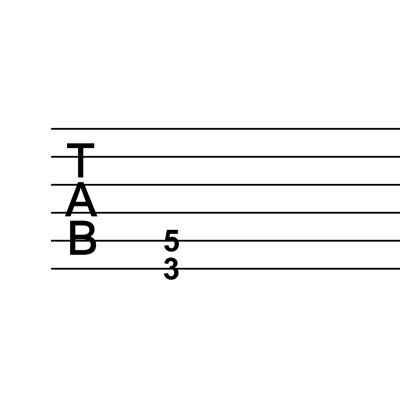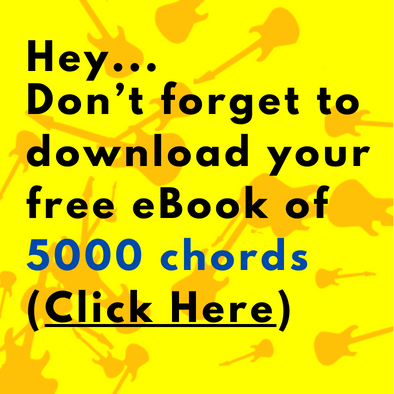If you could only ever learn to play one shape on the guitar, it would be the power chord. Think of a power chord as one easy chord that once learnt, can be re-used all over the fretboard to great effect.
What Is A Power Chord?
A power chord is a specific 2-note shape on the guitar that is moveable – it can be played up and down the neck and on different strings. This is what the shape looks when presented as a chord diagram:
This is what the shape looks like when written as tabs:
As you can see, it is a relatively simple shape. The above images show the power chord starting on the 6th string and 1st fret, but as I mentioned earlier, it can be played on any fret. The ‘shape’ just needs to stay the same. This is what it looks like starting on the 6th string and 3rd fret:
It can also be played on different strings. The same rule applies – the shape needs to stay the same. Here is a power chord starting on the 5th string, 2nd fret:
What’s So Good About A Power Chord?
So why are power chords so special? Why do we place such importance on a simple chord with only two notes? In short, it is because a power chord produces a simple, yet powerful sound. A power chord consists of a root note and a 5th (yes, theory, but don’t worry about understanding it just yet). Basically, these two notes blend together so easily that it’s often difficult for the laymen to hear that there are two different notes being played. The result is a sound that is simple, yet ‘fat’. A power chord really just sounds like a ‘fatter’ version of one note. Because it sounds like one note, it can be used in lots of different situations.
Playing Power Chords
The challenge initially with playing power chords is in getting the two notes to sound nice and clear. Just like any other chord, it can be a challenge at first. The other challenge is making sure that none of the non-fingered strings are played. This is achieved by avoiding these strings with the pick. If at first your power chords don’t sound perfect, stick with it. Once you have the hang of them, you have access to thousands of riffs/songs.
Let’s play a few power chords and then discuss them a bit more. Each of the following power chords will be written in tabs. Remember, the shape is the same for each one, so all you really need to observe is which fret and string it starts on. Try to play each one and listen to the recordings to compare. Of course, experiment with moving the shape across the fretboard and on different strings:
Power Chord Starting On 6th String, 1st Fret:
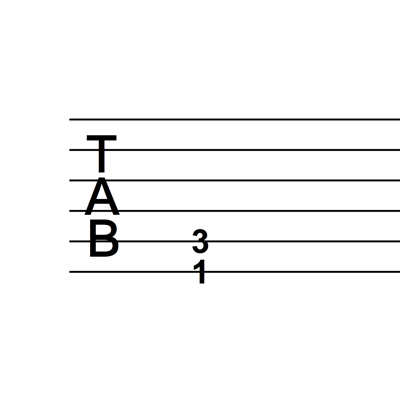
Power Chord Starting On 5th String, 5th Fret:
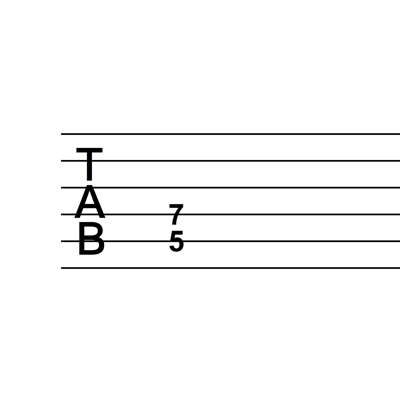
Power Chord Starting On 5th String, 2nd Fret:
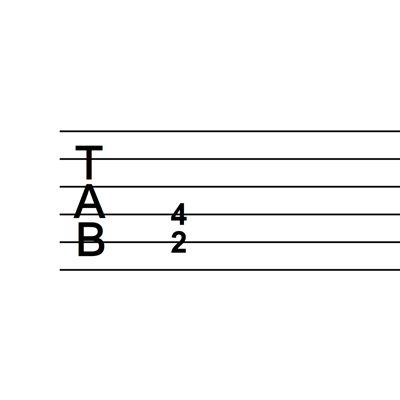
Power Chord Starting On 4th String, 2nd Fret:

The guitar in the above audio files has been recorded using distortion. Distortion gives the guitar that ‘rock’ sound and is used extensively in rock/metal styles. Distortion really brings power chords to life. Power chords can be (and frequently are) used without distortion (clean) as well. Observe how there is a powerful resonance with each power chord, but also a simplicity.
One way to observe how power chords can be used to ‘fatten up’ a guitar part, is to compare a riff being played as single notes and then as power chords.
Let’s look at one of the riffs that we did in the lesson on riffs. The first example is the riff, as it was written in the original lesson. It involves playing 1 note at a time. Here is the sheet music with audio underneath:
Riff Played Without Power Chords:
Here is the same riff, but using power chords in place of every note:
Riff With Power Chords:
As you can hear, both versions sound quite similar, but the version with power chords sounds fuller. This does not work with normal chords. You generally can’t substitute single notes of a riff with regular chords (major, minor etc.). Regular chords are complicated. Different chord types have different moods, flavours and functions. Power chords don’t have that level of complexity – they just work.
3 Note Power Chords
I know I said power chords are ridiculously simple and easy to apply. It’s true, but there is one small variation that we need to look at. So far, we have only played 2-note power chords. Power chords can however, be played as a 3-note chord. What’s the difference? Just as a 2-note power chord can be thought of as one note with a bit of extra power, a 3-note power chord can be thought as a power chord with an extra bit of power still. In other words, 2-note and 3-note power chords don’t really sound that different. In fact, most people would struggle to identify the difference at all. They might say that one was a little louder. This is because with the 3-note power chord, all we are doing is doubling up on the root note, up one octave (again, don’t worry if you don’t understand the terminology just yet, we’ll get there in good time).
Here is the 3-note power chord shape. Observe the 2-note power chord shape to the right as well, and compare the difference:


Experiment with playing them both and observe the difference. The 3-note version can be moved around just like the 2-note version. Here is an example of playing both versions starting on the 6th string, 1st fret:


3-Note Power Chord Audio
2-Note Power Chord Audio
Here is the riff that we looked at before. This time we will use 3-note power chords. Have a look/listen and try it yourself. Compare the 3-note version with the 1-note and 2-note versions that we have already done.
Do Power Chords Have Names?
Because of the simple nature of power chords, we often don’t refer to specific ones by name. However, they can be referred to by their root note. The ‘root note’ of a power chord is simply the lowest (pitch-wise) note of the chord. Observe the following picture.
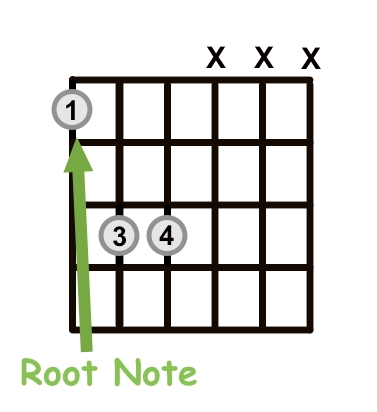
So based on this, we could call a power chord that is played on the 3rd fret of the 6th string a G power chord (because the root note is G). This requires a knowledge of the notes along the fretboard, which we haven’t really explored yet, but we will in an upcoming lesson.
Sometimes you can see power chords written with a ‘5’. For example, a B power chord would be a ‘B5’ chord. An F power chord would be as ‘F5’. How do we know to play a 2-note power chord or a 3-note power chord? With the above labels, we don’t really. But often, you can choose. They both sound similar, so they are often interchangeable. As well as this, music with power chords is often written in tabs, so you rarely have to worry about labels. After all, we want to keep things simple here!
Where Can You Not Play Power Chords?
I know I said that power chords can be moved across the fretboard and also up and down strings. While this is true, we generally no not use the 1st (E) and 2nd (B) strings. This is for two reasons – the interval between the 3rd (G) string and 2nd (B) string changes, so the shape would have to change to accommodate this interval change. Also, power chords are meant to sound deep and powerful. When we use the first two strings, they lose their effect. Here are some pictures to illustrate which groups of strings power chords work with:
2-Note Power Chords





3-Note Power Chords




Power Chords With Open Root Note





The above images show how to play a power chord with an open root note. This is important because open power chords are used often. While it may look like a different shape, it is essentially the same as a regular power chord. The image below shows why:

As you can see from the image, if we move a power chord down, one fret at a time, the finishing point is with the root note being a 0 (not a 1). If this is confusing, literally play the tabulator and it should make more sense.
Let’s Get Playing
Although it feels like there has been a lot of material covered in this lesson, there are really only two main things that you should take away from it – knowing how to play power chords, and knowing that they are awesomely useful. They’re something that you should practise until you can do them with ease. You don’t need the exercises in this lesson to do so, but here are a few more anyway. Have fun!
Power Chord Riff 1
Power Chord Riff 2
Power Chord Riff 3
5 Popular Examples
Power chords can be found in many many songs across different styles. Here are just five:
- Smells Like Teen Spirit (Nirvana) – Listen to the open riff (and pretty much the whole song!).
- Song 2 (Blur) – Listen to the opening riff. A good example of power chords played without distortion and on the 3rd and 4th strings.
- Iron Man (Black Sabbath) – Listen to the main riff.
- Rolling In The Deep (Adele) – The main riff at the start uses power chords.
- Layla (Eric Clapton) – Listen to the acoustic version. A good example of how power chords can be used on acoustic guitar in place of regular chords.
Congratulations on be initiated into the world of power chords. Your life will never be the same.

